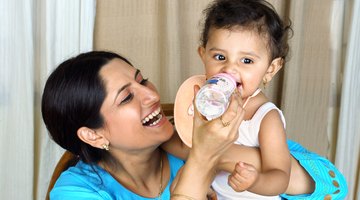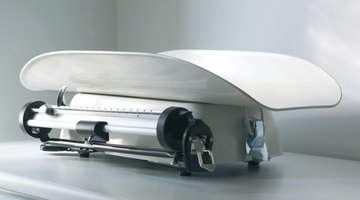How Much and How Often Should a Four-Month-Old Eat?
At 4 months old, your baby may not quite be ready to handle solids but she is gradually approaching that milestone.
She has about doubled her birth weight, her stomach has grown a lot since birth and she can handle larger amounts of breast milk or formula at a time, according to BabyCenter. Although you should ask your baby’s pediatrician for individualized feeding tips, knowing typical eating habits for 4-month-olds will help you keep your baby satiated.
How Much
As long as your baby isn’t eating any solids yet, he should be getting about 2.5 oz. of formula for every pound of body weight every day. Therefore, if he weighs 14 lbs. he should be drinking about 35 oz. of formula a day, according to BabyCenter.
If your baby is breastfeeding and not eating solids yet, he should be getting about 26 to 28 oz. of breast milk per day. Still, your baby is an individual and he may need slightly more or less to support his unique development.
How Often

How Many Ounces of Milk Should a 7 Month Old Baby Have a Day?
Learn More
Your baby will drink fewer bottles of formula each day since she will be able to drink more at a time. By his fourth month, she may have about four or five 6- to 7-oz. bottles per day with three or four hours in between, according to BabyCenter.
If your baby is breastfeeding exclusively, she may still want to have about six to eight feedings per day.
However, reading your baby’s hunger cues and feeding her on demand is more important than timing and counting feedings precisely. Some signs that she needs to be fed include putting her hands near or in her mouth, moving her head from side to side, opening her mouth, sticking out her tongue and puckering her lips in a sucking motion.
Healthy Signs
Don’t try to feed your baby more as long as he is showing signs of getting enough nourishment. A well-nourished breastfed baby should gain between 2.5 and 4.5 oz. per week, seem satisfied and relaxed after a feeding and wet six to eight cloth diapers or five to six disposable diapers per day. Your breasts should also feel softer after each feeding.
A well-nourished formula-fed baby should show similar signs of relaxation and satisfaction after a feeding and have the same number of wet diapers.
However, he may continue gaining weight at a slightly faster pace than a breastfed baby, according to “Parents” magazine. Get in touch with your pediatrician if you believe your baby isn’t eating enough.
Considerations

How Much Should Babies Be Eating at 10 Weeks?
Learn More
Although the American Academy of Pediatrics generally recommends that you exclusively breastfeed your baby for six months, your doctor may suggest that you begin giving your baby some solids in your baby’s fourth month if he thinks she is ready. For instance, a baby who is ready to start eating solids should be able to sit properly in a high chair, make chewing motions, have an interest in food and move food from the front to the back of his mouth.
She should also be teething and seem hungry after eight to 10 breastfeedings or 40 oz. of formula per day. If your baby is ready, your pediatrician will recommend that you continue primarily feeding your baby with formula or breast milk but also offer your baby about 1 tsp. of rice cereal mixed with 4 to 5 tsp. of formula or breast milk every day.
Related Articles
- KidsHealth from Nemours: Feeding Your 4- to 7-Month Old
- American Academy of Pediatrics: Switching to Solid Foods
- BabyCenter: Age-By-Age Guide to Feeding Your Baby
- BabyCenter: How to Tell Whether Your Baby’s Getting Enough Breast Milk
- BabyCenter: How to Tell How Much Formula Your Baby Need
- KidsHealth from Nemours: Formula Feeding FAQs










